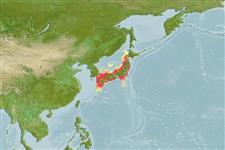Environment: milieu / climate zone / depth range / distribution range
Ecology
Marine; pelagic-neritic; oceanodromous (Ref. 51243); depth range 0 - 275 m (Ref. 54927), usually 50 - 275 m (Ref. 54927). Tropical; 46°N - 13°N, 105°E - 148°E
Northwest Pacific: southern Japan, Korean Peninsula to the East China Sea. Pacific Ocean off the coast of southeast Asia.
Length at first maturity / Size / Weight / Age
Maturity: Lm 19.0, range 18 - 20 cm
Max length : 50.0 cm TL male/unsexed; (Ref. 56557); common length : 35.0 cm TL male/unsexed; (Ref. 56557); max. published weight: 660.00 g (Ref. 40637); max. reported age: 12 years (Ref. 56557)
Adults occur on continental waters (Ref. 41299). Pelagic (Ref. 52947). Juveniles associate with drifting seaweed (Ref. 12114, 12115).
Masuda, H., K. Amaoka, C. Araga, T. Uyeno and T. Yoshino, 1984. The fishes of the Japanese Archipelago. Vol. 1. Tokai University Press, Tokyo, Japan. 437 p. (text). (Ref. 559)
IUCN Red List Status (Ref. 130435: Version 2024-2)
Threat to humans
Harmless
Human uses
Fisheries: highly commercial; aquaculture: commercial
Tools
Special reports
Download XML
Internet sources
Estimates based on models
Preferred temperature (Ref.
123201): 1.8 - 22, mean 13.8 °C (based on 75 cells).
Phylogenetic diversity index (Ref.
82804): PD
50 = 0.5001 [Uniqueness, from 0.5 = low to 2.0 = high].
Bayesian length-weight: a=0.01096 (0.00923 - 0.01302), b=2.97 (2.94 - 3.00), in cm total length, based on LWR estimates for this species (Ref.
93245).
Trophic level (Ref.
69278): 3.4 ±0.45 se; based on food items.
Generation time: 3.1 (1.6 - 3.9) years. Estimated as median ln(3)/K based on 11
growth studies.
Resilience (Ref.
120179): Medium, minimum population doubling time 1.4 - 4.4 years (K=0.14-0.38; tmax=6).
Prior r = 0.55, 95% CL = 0.36 - 0.82, Based on 1 full stock assessment.
Fishing Vulnerability (Ref.
59153): Moderate vulnerability (35 of 100).
Climate Vulnerability (Ref.
125649): Low vulnerability (20 of 100).
Nutrients (Ref.
124155): Calcium = 386 [198, 652] mg/100g; Iron = 4.01 [2.35, 6.81] mg/100g; Protein = 18.6 [17.7, 19.4] %; Omega3 = 0.208 [0.126, 0.330] g/100g; Selenium = 50.3 [30.5, 90.1] μg/100g; VitaminA = 28 [7, 124] μg/100g; Zinc = 3 [2, 4] mg/100g (wet weight);
